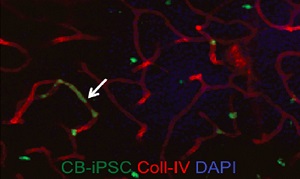 |
| The white arrow shows iPS cell-derived vascular stem cells incorporating into a damaged retinal blood vessel and repairing it.--Courtesy of Imran Bhutto, Johns Hopkins Wilmer Eye Institute |
Human induced pluripotent stem (iPS) cells have been lauded for their ability to differentiate into any type of cell in the body, making them extremely promising for the treatment of countless diseases. But engineering these stem cells involves using viruses, which can be harmful to healthy tissue in the body. Now, Johns Hopkins researchers have developed a safer way to make human iPS cells, and using these cells, they've successfully repaired damaged retinal vascular tissue in mice.
Johns Hopkins stem cell biologist Dr. Elias Zambidis and his colleagues detail this new process in a report published Jan. 20 in the journal Circulation.
"We began with stem cells taken from cord-blood, which have fewer acquired mutations and little, if any, epigenetic memory, which cells accumulate as time goes on," says Zambidis, an associate professor of oncology and pediatrics at the Johns Hopkins Institute for Cell Engineering and the Kimmel Cancer Center, in a statement. The scientists coaxed these cells into a 6-day-old, embryolike state.
Typically, scientists generate iPS cells by using cells from a skin or blood sample packaged in so-called viral vectors to carry new DNA into unhealthy tissue. The biggest barrier to iPS cell therapies moving toward the clinic is the potential for viruses to introduce foreign DNA and cause gene mutations or spur cancers in healthy adult cells.
Instead of using viruses to deliver a gene package to the cells to turn on processes that revert the cells back to an embryonic-like state, Zambidis and his team used plasmids, rings of DNA that replicate briefly inside cells and then degrade.
The investigators then identified high-quality, multipotent vascular stem cells generated from these iPS cells that can make a type of blood vessel-rich tissue that plays a vital role in repairing retinal and other human material. Multipotent stem cells are in essence committed to producing specific cell types, and the Johns Hopkins researchers pinpointed these specific multipotent cells by looking for cell surface proteins called CD31 and CD146. Compared to iPS cells made with viral vectors, Zambidis says his team was able to create twice as many well-functioning vascular stem cells.
Researchers injected the newly derived iPS cells into mice with damaged retinas, observing that the iPS cells engrafted and repaired blood vessel structures in the retina.
Zambidis said in a press release that his team plans to carry out more experiments of their cells in diabetic rats, whose condition more closely mimics human vascular damage to the retina than the mouse model used for the current study.
- see the study abstract
- read the press release